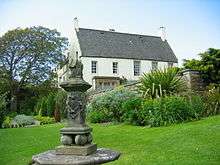Inveresk Lodge Garden
Inveresk Lodge Garden is a garden in the care of the National Trust for Scotland, in the village of Inveresk, East Lothian, Scotland, UK, south of Musselburgh.

History
Inveresk Lodge was built in 1683, and between 1774 and 1911 it was the home of the Wedderburn family.
The portrait painter Archibald Skirving died at the Lodge in 1819.
John Brunton, a Quaker, bought Inveresk Lodge in 1911. His Brunton Wireworks provided the cable for the Forth Road Bridge. During World War II, Inveresk Lodge's garden was needed to grow vegetables in support of the war effort. In 1958, Mrs Helen Brunton left the house and gardens to the National Trust for Scotland. The Lodge is let by the Trust for private occupation, but visitors can enjoy the terraced garden.
Garden
The earliest evidence of a garden at Inveresk comes from a 1781 court case to reduce trees overhanging from Inveresk Lodge's Garden to Halkerson's lodge next door.[1]
At the start of the 20th century, four gardeners were employed at Inveresk Lodge. After having been used for vegetable growing for the war effort, the garden became neglected. The National Trust redesigned the garden so that it could be managed by just one gardener.
Inveresk Lodge Garden is a hillside garden, composed of a series of garden rooms, each with its own season and theme. Many of the plants have been recognised by the Royal Horticultural Society with an "Award of Garden Merit".
Main features:
- Rose border designed by the horticulturalist and artist Graham Stuart Thomas
- Victorian conservatory, greenhouse and aviary
- herbaceous borders
- Woodland walk
- Meadow pond
- Croquet lawn
- Island beds
- Summer house
Photo gallery
 Inveresk Lodge
Inveresk Lodge Lodge & Croquet Lawn
Lodge & Croquet Lawn Ferns in the Glasshouse
Ferns in the Glasshouse A garden room
A garden room Aviary
Aviary Wildlife pond
Wildlife pond Conservatory
Conservatory Sundial
Sundial
References
- Inveresk Lodge Garden Conservation Management Plan, 2010, NTS garden department archives
External links
- Inveresk Lodge Garden - official site at National Trust for Scotland